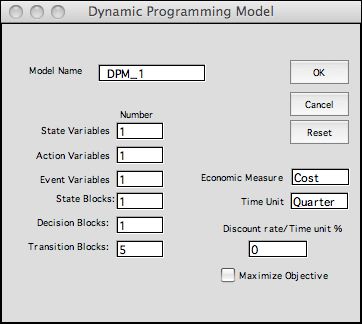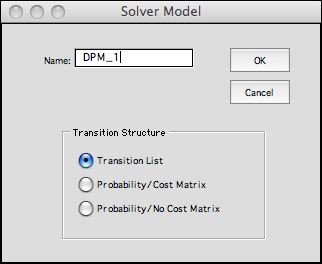|
|
 |
Dynamic
Programming
Examples |
 |
-
Replacement |
| |
This example comes
from a book Dynamic Programming and Markov
Processes by Ronald A. Howard, (MIT Press, Cambridge,
Massachusetts, 1960). It involves the replacement of capital
equipment that ages over time. The model is constructed
by the DP Models add-in as described on this page and solved
with the DP Solver add-in. The solved model is described on
the next page |
Creating the Model Form |
|
|
The data table is at the left. It is placed
on the worksheet to the right of the model columns.
Time is measure in three month intervals,
called quarters in our model. The time horizon for this model
is 10 years, or 40 quarters. Deterioration is indicated by
increasing operating expenses over time. The operating expense
in column AA is the cost for the next year of operation.
At the beginning of any quarter
there is a choice to replace the equipment with a new one,
replace it with a reconstructed unit of a given age, or keep
the currently owned equipment for one more quarter. The purchase
costs of new and reconditioned equipment is given in column
Y. The purchase cost of replacement equipment decreases with
age.
If the current equipment is replaced, a revenue is realized
that is the trade-in value of the equipment. This is in column
Z. The trade-in value decrease with age. The trade-in value
is less that the purchase cost of the same aged equipment.
When the equipment is purchased, the next state is one later
than the purchase age. So, when we purchase an equipment of
age 0, we next observe it age 1.
The equipment has a survival probability for the next quarter
that depends on age as in column AB. A new equipment will certainly
survive, while older equipment have decreasing survival probabilities.
When the equipment fails it immediately becomes the same as
a 10 year old equipment (40 quarters). If it survives the equipment
becomes one quarter older.
Equipment that is 40 quarters in age that is not replaced
remains at 40 quarters.
Cell AD10 holds the maximum age. |
|
|

|
Choosing the Add Model option
from the DP Models add-in, opens a dialog box that selects
the type of model. Here we have chosen the Stochastic DP option,
because we are modeling a Markov Decision Process.
We have decided to model this problem with one state variable,
one action variable and one event variable as entered in the
appropriate fields. We include one state block and one decision
block. These will not be important for this model, but they
included in order to retain the option of more blocks later
in the problem. We describe the five transition blocks below.
On clicking OK, the entire worksheet is prepared. You should
download and open the Replace workbook to follow this
discussion. The workbook is saved without control buttons.
You can add new buttons with the Start command from
the DP Models menu.
The three principal elements are shown below. |
|
| |
The state variable
indicates the age of the equipment. It ranges from 1 to 40.
The age is observed at the beginning of each quarter. Even
if a new equipment is purchased, it will be at age 1 when next
observed. The display
shows quarter 28. The index in E14 is manipulated by the add-in
during the enumeration process. The spinner control in row
H can be used to manually adjust the state up or down during
model debugging. There are 40 possible states.
The action variable indicates the decision at the beginning
of each quarter. For this discussion use x to indicate
the action. When x = 1, shown here, the equipment
is kept for one more quarter. Other values of x means
to trade in the current equipment and purchase a replacement
of age x -
2. Thus x = 2 means to purchase a new equipment.
When x = 41, the action is to purchase an equipment
of age 39. There are 41 possible actions and each is available
in any state.
Cell K21 contains a formula that describes the cost of an
action. The formula includes an Excel IF function that depends
on both the state (s) and the action (x).
The cost is for the next period and looks something like this:
=IF(x=1, OE(s + 1), -(TD(s + 1))+P(x -
1)+OE(x - 1))
The indexing may seem odd, but it is due to the action being
2 greater than the purchase age and table index being one greater
than the age. For the keep action, the cost of keeping
an equipment of age 28 for one more quarter is 141.
There are two events represented a binary variable with 0
indicating failure and 1 indicating success. Costs and probabilities
depend on both state, action and event and computed in the
transition blocks. The entries in rows 21 and 22 are the default
values.
To the right of the figure starting in columns S is the summary
for this state/action/event combination. It indicates that
the feasibility conditions for state, decision and transition
are all satisfied for this combination. We must look into the
remainder of the worksheet to see what this means. |
State and Decision Blocks |
| |
The model has one
state subset block and one decision block. They perform no
function for this example. The default values supplied here
do not limit or change the objective terms already defined
by the state and action variable definitions. |
|
Transition Block 1 |
| |
The transition block
area is headed by rows 53 through 57 that repeat the state action
and event defined by the elements at the top of the model. Formulas
in the transition blocks should point to these copies rather
than the values in row 14. The values on row 56 are closer to
the transition blocks and are therefore easier to use. For some
enumerations the values on row 56 are disconnected from row
14, to reduce computational effort. |
|
| |
The first transition
block is feasible when the age of the equipment is less that
40 (the max age), the action is to keep the equipment and the
event is a success. These conditions are implemented by the bounds
in rows 61 and 62. If all this combination is true, the transition
simply increases the age of the equipment. The number 1 is placed
in cell F64 to accomplish the transition. The new state is indicated
in row 66 as age 29. It's index in the state table is also
29. Cell H66 is TRUE when the next state is in the state table.
The probability of
this event is placed cell U61. That cell contains a formula
that points to the probability column of the data table for
the row determined by the current age. You will find the number
0.85 in the table for age 28. We call a number from this table p(s).
The entry in cell U61 is p(28) |
Transition Blocks - Keep |
| |
The figure below shows
both block 1 and block 2. In this case we are viewing the effect
of the event of a failure. The event variable is 0. Because the
bounds in the event section of block 1 are both 1, the first
transition block does not describe the current combination. This
is indicated by the expression FALSE in U60.
Block 2 was designed
for this kind of combination as the bounds on the event are
both 0. Cell F74 holds the expression: 40 - s. This
evaluates to 12 for the current state and the result is a transition
to state 40. This is the result of the failure event.
The expression for the probability in
U71 is: 1 - p(28). This is the probability
of failure for age 28. |
|
Transition Blocks - Buy |
| |
Transition blocks
3 and 4 describe the transitions for the Buy action.
For these blocks the action variable ranges from 2 to 41. All
ages are allowed by the state range. For illustration we use
the action 6, buy an equipment of age 4. Block 3 describes
the event of success for
the next quarter, and block 4 describes the event of failure.
Note that the transition in block 3 results in a new state
representing age 5. A failure, block 4, results in a transition
to age 40.
The transactions for the process are assumed to occur at
the beginning of the quarter, so the probabilities of success
or failure depend on the action, not the state. The formula
for the probability in block 3 is p(x-1)
and the probability of failure in block 4 is 1-p(x-1). |
|
Transition Block - Age 40 |
| |
The last transition
block describes the keep option for age 40. At age 40,
the equipment will surely fail. |
|
The Complete DP Model |
| |
Before constructing the transition
blocks it is important to click the List States button
at the top of the page. A transition box will not be effective
unless the transition leads to a feasible state. A state is
judged to be feasible when it is in the State List.
To review the lists implied by the model click the List
Elements button. The add-in enumerates all states and
actions to construct the state, action and event
lists. Then the add-in enumerates all feasible states
and actions to find the decision list. In this case
all actions are feasible in all states, so we have 1640 rows
of the decision list. There is two transitions in each state.
Deleting the transitions with zero probability there are
3239 transitions.
The example is interesting because the state space is small
with only 40 states, while the decision space is large with
over 1600 decisions.
Clicking the Transfer to DP Solver button creates
the lists. builds a DP Solver form, and transfers the model
lists to the DP Solver form. We choose the Transition List option,
but the other options are also available because of the small
number of states.

The DP Solver model for this problem is
on the next page. |
| |
|
|



